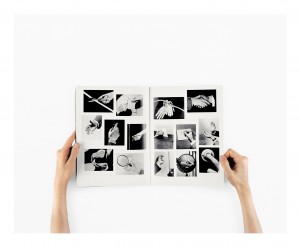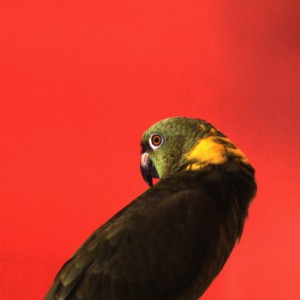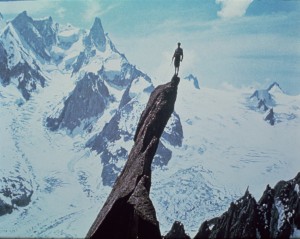
C-print
50 3/4 x 61 3/4 x 1 3/4 in. framed
Courtesy the artist; Anton Kern Gallery, New York; Marc Foxx Gallery, Los Angeles; Corvi-Mora, London; and the Modern Institute/Toby Webster Ltd., Glasgow
It could be argued that, ever since Andy Warhol intrigued and scandalized (yes: scandalized, at the time) art audiences in the 60s with the conceit of pop culture regurgitations of mass market products (or, if one is to be entirely precise, when Marcel Duchamp’s ‘found’ urinal named “R.Mutt” outraged the Society of Independent Artists in 1917), that the entire foundation of an artist’s worth, in subsequent decades, has been dealing with the idea of authorship.
However, in a digital world of retweeting, and video homage, and postmodern ideas of personal or group authorship, maybe nobody even cares that much anymore? After all, after a thousand, thousand, museum exhibitions of appropriated imagery, wherein artists have so cheekily challenged audiences with provocations of “authenticity” isn’t it a bit of an old chestnut to even consider “how” artists” use appropriated imagery; rather than that much more interesting question… “why”?
Seen in this context, Ordinary Pictures is a ground-breaking exhibition organized by the Walker Art Center in Minneapolis: that takes that old chestnut of appropriated imagery, and, simply, files it under “m-eh”– and thereafter proceeds to survey a range of conceptual picture-based practices since the 1960s through the lens of the stock photograph and other forms of industrial image production; aiming to ask much more interesting aesthetic and conceptual question of what we might see – and judge – in front of our eyes.
Stock imagery might seem like the ‘poor cousin’ of artistic endeavor, but, despite its apparent throwaway status, the stock image is the primary commodity of a $1 billion global industry with far-reaching effects in the marketplace and the public sphere. Ordinary Pictures effectively removes the old notions of authorship, but simultaneously centers the artist’s purview into how they manipulate stock imagery for new perspectives.

silver-dye bleach print
19 5/8 x 19 5/8 in.
Private collection
Courtesy the artist and Metro Pictures, New York
For instance, what is special about a picture of a parrot (yes: this is a trick question?)? Artist Louise Lawler’s “Portrait” (1982) is a stock image of a parrot against a red background, it’s head tilted toward the viewer, fixing us with its beady eye (almost a substitute for the unyielding gaze of the camera lens?); but it possesses an undeniable hypnotic power. Compelling, engaging, it makes us wonder about the current trend of regurgitated “cute pet” photos; and reclaims the core alien nature of animals without resorting to convenient anthropomorphism.
Moving beyond the still image, Filmmaker Steve McQueen (director of the Oscar-winning “12 Years a Slave”) presents “The Golden Record” (2002). Using, as its starting point, a collection of generic images sent out into the cosmic void on the Voyager probe, the original collection represents a snapshot of the ‘treaty’ that cosmologist Carl Sagan wanted to represent humanity if aliens even found the probe; whereas McQueen repurposes the material against a soundtrack of people speaking in tongues.

35mm slides transferred to digital, sound; running time 70 minutes
Collection Walker Art Center, Gift of Michelle and Bill Pohlad, and the T. B. Walker Acquisition Fund, 2014
Assuming the industry (and comedy) standard that we need three examples (or jokes) to make a point; another solo work within the extensive exhibition is “Artist Looking at Camera” (2006) by Guthrie Lonergan. A playful, if challenging, work, it shows us stock images/footage of artists looking back at us: do they challenge us with their gaze? Are we supposed to be the object? Or, because we are ‘watching’ them, are they the subject? It’s an intriguing play on authorship, and an inversion of the artist’s gaze, that goes way beyond the old tropes of creative ownership. As such, it’s part if a richly playful and compelling subversion; just one of numerous works that force the viewer to simultaneously engage, but then not care that much, about the source material. All of us, all of that which we are, can seem to be up for grabs; but then not that important either; but then very important. It’s a delicious conflict, full of mischief but profundity.

video (color, silent); running time 3:04 minutes
Courtesy the artist
According to the Walker Art Center: “Focusing on the industry’s distinctive modes of production, distribution, and presentation, Ordinary Pictures foregrounds the work of artists who have done much to probe, mimic, and critique this overlooked aspect of our visual environment. Spanning generations and movements—from early Pop work, avant-garde film, and Pictures Generation appropriation to more recent collage, photography, and video work—the exhibition also considers contemporary art’s own function as an ever-expanding global image economy.”
The exhibition includes works by Richard Artschwager, John Baldessari, Steven Baldi, Mary Ellen Bartley, Lucas Blalock, Tom Burr, Sarah Charlesworth, Anne Collier, Phil Collins, Michael de Courcy, Liz Deschenes, John Divola, Aleksandra Domanović, Hans-Peter Feldmann, Morgan Fisher, Hollis Frampton, Jack Goldstein, Rachel Harrison, Robert Heinecken, and Leslie Hewitt.
For more details: http://www.walkerart.org/calendar/2016/ordinary-pictures
